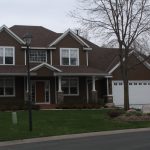Modern homeowners are becoming more environmentally conscious with each passing year, but they also want siding options that are durable, affordable, and look great on their homes. After considering life-cycle performance criteria such as materials, manufacturing practices, and recyclability, there are many eco-friendly siding options that homeowners can choose between.
#1 Fiber Cement Siding
When homeowners want the look of wood siding at a lower price, they nearly always consider fiber cement siding. Fiber cement siding is composed of cement, sand, and wood pulp that manufacturers fuse together with high heat and set within molds to give it wood-grain markings. Fiber cement is exceptionally durable and can last many years with minimal upkeep. While this siding choice doesn’t give off toxins when burned, fiber cement siding manufacturers use a lot of energy to produce the siding.
#2 Stucco Siding
Homeowners who have property in hot, dry climates are wise to choose stucco siding for their homes, but it also makes a house stand out (in a good way) in Minnesota neighborhoods. Traditional stucco is made up of cement, water, sand, and limestone. It doesn’t release toxins, and it helps to insulate homes from the sun’s hot rays. A more environmentally-friendly stucco siding choice omits the cement and subsequently cuts greenhouse gas emissions during processing.
#3 Aluminum Siding
Despite having been largely replaced by vinyl siding over 40 years ago, aluminum siding remains a front-runner for affordable green siding. You can get aluminum siding that’s made from 100 percent recycled metal. This siding choice is known to last up to 50 years with little maintenance, and it resists water, rot, and fire.
#4 Wood Siding
Wood is a natural material that is sustainable, degradable, and recyclable. While you want to make sure that you pick wood siding that’s made from responsibly harvested lumber, wood siding is non-toxic and can be salvaged for other uses at its end of life.
Bark siding, which uses bark from poplar trees, is a more renewable wood siding product than regular lumber-based siding. Charred or burnt siding uses a popular Japanese manufacturing method that results in wood siding that resists water damage, rot, and fire. Traditional wood siding lasts about 20 years with diligent maintenance, and charred wood siding keeps its looks for nearly 100 years without much maintenance.





